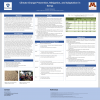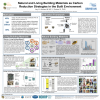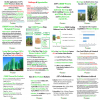As climate change risks and global human population grow, we need to design sustainable buildings that are closely tied to nature to reduce carbon emissions while simultaneously improving health outcomes. Phipps Conservatory and Botanical Gardens views humans and ecosystems as inextricably connected, rather than separate, and demonstrates how technology and building design can maximize both human and environmental health.
Materials & Waste Research Posters
A Methodology for Calculating the Fiber Footprint of a Large Organization : A Case Study of Penn State University
The sustainability of an organization cannot exceed that of its supply chain. This realization has led many organizations to consider how procurement functions can impact sustainability of operations. Metrics to evaluate sustainability performance of procurement outcomes often focus on reducing overall material purchases and purchasing products having third-party certifications. Such metrics have limited utility for assessing environmental impact of purchasing decisions.
Battery Health Assessment Using Ultrasonic Testing
Batteries are used throughout many sectors for energy storage, but issues with degradation related to both use and time can affect their efficiency. As the world depends more and more on batteries for uses like electronics, electric vehicles, and storing renewable sources of energy, assessing the health of these batteries is increasingly relevant. Current methods to check battery health rely on checking the voltage or current and using state-estimation software.
Cafeterias are Classrooms: Measuring Student Food Waste in the National School Lunch Program
The expanding footprint of food and agriculture represents one of the biggest threats to biodiversity on the planet. Even more problematic, it’s estimated that the US wastes 63 million tons of food every year. A large percentage of this food waste ends up in landfills where it emits harmful methane greenhouse gas emissions, while also wasting water, energy and wildlife habitat that was sacrificed to grow [wasted] food.
Clayey Soils and Waste Brick Powder for Partial Cement Replacement
This research is an exploration of materials that can be used as partial replacement of cement in mortar or concrete. According to the International Energy Agency, cement production accounts for 7% of industrial carbon dioxide emissions and one of the key areas of reducing these emissions is increasing the use of blended cements.
Climate Action Accelerator for Campuses: "Drawdown Campus"
Schools are pillars of communities. They provide children with inspiration, knowledge and tools to take into the world. Due to concerns about the climate crisis, biodiversity and plastic pollution facing our planet, students across the world are mobilizing and striking in protest of the lack of action, to raise awareness and to demand change to protect our futures.
Climate Change Across the Curriculum: Teaching 'Drawdown' Solutions in Higher-Education
Climate change affects every aspect of our world, from human health and the ecosystems we live in to the ways we support ourselves both materially and emotionally. But the siloed world of higher education can make it difficult to present cross-cutting solutions to climate change in the classroom.
Climate Change Prevention, Mitigation, and Adaptation in Kenya
Climate change is a phenomenon that has major implications across our entire plant. Within just the continent of Africa, The Fifth Assessment Report of the Intergovernmental Panel on Climate Change (IPCC) “presented strong evidence that surface temperatures across Africa have increased by 0.5-2°C over the past 100 years, and from 1950 onward climate change has changed the magnitude and frequency of extreme weather events” (Kenya NCCAP 2018-2022, 2018).
Clothes Are Not Trash: Clothing Recovery on a College Campus in the Nation’s Capital
The abundance and availability of inexpensive clothing reduces its value to the customer to the point of conveying disposability. In 2014, according to the World Resources Institute, the average consumer purchased 60 percent more items of clothing as compared to 2000, but each garment was kept half as long. This emerging “fast fashion” consumer demand has major repercussions for the climate.
Cotreatment-enhanced Anaerobic Digestion of Lignocellulosic Biiomass
Anaerobic digestion is a method of biomass degradation via microbial activity in the absence of oxygen. This process creates useful products like digested solids, which can be used as fertilizer, and biogas, which can be upgraded to produce renewable natural gas. Lignocellulosic materials, like grasses, woody materials, and agricultural residues are favored for this process due to their affordability and availability.
Developing Wind Energy Curriculum for First Year Engineering Seminars
In the midst of a climate crisis, it is imperative that Penn State as an institution educates students to be aware and critical of the context and impact of their professional work. This means rooting the College of Engineering curriculum in sustainability and ethics. To accomplish this, we have developed wind energy curriculum for Penn State’s First Year Engineering Seminars (FYS).
Drawdown Learn Conference: Empowering Schools & Communities to Address Climate Change
The Omega Center for Sustainable Living (OCSL) opened in 2009 with the construction of our EcoMachine, a natural wastewater reclamation facility designed in partnership with acclaimed biologist, John Todd. As the world’s first LEED Platinum and Living Building Challenge certified project, the center receives thousands of visitors and many school groups each year. In 2018 we worked with Project Drawdown to produce the first Drawdown Learn Conference.
Emissions Abatement via Implementation of Electrocaloric Cooling in Residential Air Conditioning
Air conditioning systems negatively affect the environment; their electrical consumption and leakage of the refrigerant required to run them contribute to global warming. As the planet warms and global GDP increases, the demand for these systems will rise world-wide, stressing energy grids beyond capacity and preventing compliance with global refrigerant and emissions reduction goals.
Energy Impacts of Improved Signal Transmission Systems Used in Autonomy
All devices signal fidelity, range and power consumption are linked to the quality of the transmitting and receiving antenna hardware. With advent of 5G, CubeSat constellations and increasingly autonomous machines, the architecture and impact on electrical grid/power choices are growing increasingly complex. Autonomous Cargo Ships, Logging Equipment, Farm Tractors, Trucks, Planes and Cars are now in use.
Engineering Ethics for First Year Seminar Courses
Engineers develop advanced technology that benefits society. Engineers’ ethics focus on human well-being, health, and safety that are essential to provide an improved quality life for individuals, society, and our planet. Climate change is a societal issue that encompasses these three ethical focuses. Therefore, climate change topics should be included in the engineering students’ curriculum.
Feeding Cities: Reconfiguring Urban Environments and Food Systems for Future Resilience
As we move towards a global population of 9 billion + with our urban areas hosting most of the planets people, the need to be creative in providing quality food in a responsible way is ever greater.
Full-Circle Nutrient Management for Regenerative Agriculture in a Local Watershed
The overarching goal of this project was to evaluate the feasibility of full-circle nutrient management by absorbing nutrients (N, P, and K) from wastewater effluents and agricultural runoff into aquatic plant biomass (ex., duckweed), and then using that biomass as a sustainable soil amendment to support regenerative agriculture.
Green Theatre in Training, College Green Captains and the Broadway Green Alliance
Live Entertainment Production, including Sports, Concerts and Theatre are resource intensive. Live events demand purpose built stadiums, theatres and substantial infrastructure investments. These investments impact utilities, transportation, parking/stormwater and facility maintenance. There are also short term scenic elements purpose built for single shows. The Broadway Green Alliance is dedicated to reducing the overall environmental footprint of live production.
Ice911 Research: A Reversible Localized Geo-Engineering Technique to Mitigate Climate Change Effects
It is now known that the accelerated loss of Arctic Ice has a profound global effect, causing extreme weather events and driving up global temperatures.Ice911 is a nonprofit based out of Silicon Valley with the mission of restoring Arctic sea ice. Currently, Ice911 is acknowledged as the furthest ahead Arctic restoration effort in the world.
Impact of Bioplastic Use on Greenhouse Gas Emissions
Throughout the past several years, researchers have been trying to understand the positive and negative effects of the implementation of bioplastics into an industrial and commercial setting. The analysis of greenhouse gas emissions of bioplastics compared to oil-based plastics will help to determine if a conversion is necessary to draw down greenhouse gases.
Indiana Drawdown
Indiana Drawdown is inspired by Georgia Drawdown and others. It's grassroots and modeled after the opensource software movement. It values radical transparency and participation. Our main goal is to reduce Indiana's emissions 45% by 2030, as the IPCC says we must.
We've identified 200 entities already implementing Drawdown solutions in Indiana. Most don't know about Drawdown or how impactful their work is regarding climate change.
Investigating the Impact of Green Roofing Carbon Sequestration with GHG Emissions in Structural Reinforcement Production
In order to achieve proper carbon sequestration, it is estimated by Project Drawdown that as much as thirty percent of worldwide roofing area (136B Sq. ft.) be converted to green roofing. In newly built structures, green roofing is accounted for before construction by reinforcing the structural design of the building. However, in order to achieve thirty percent green roofing space worldwide, it is necessary to convert older structures as well.
Localizing Drawdown: Collaboratively Building Regenerate Lancaster
Regenerate Lancaster is a collective of co-working individuals launching a Drawdown plan for Lancaster County, PA. Grounded in sustainability as a regenerative project for communities, economies, and ecologies (cf. Lovins, Wallis, Wijkman & Fullerton 2018; Raworth 2018; Rodale Institute; UN SDGs), we are identifying the twenty-five most relevant solutions for our place, connecting organizations to act on these solutions, and nurturing the initiatives we seed within our community.
Mirrors for Earth’s Energy Rebalancing (MEER:ReflEction): Resource-Driven Engineering Leveraging Earth’s Chemistries to Immediately Offer Remediation
Anthropogenic aerosols and greenhouse gases (GHG) enter the atmosphere as peoples exercise their unalienable rights in pursuit of well-being and prosperity. Once airborne, the aerosols cool the Earth almost as much as co-emitted GHG warm it. This balancing act has masked an additional 1C of warming, should the aerosols disappear when phasing out the fossil fuels without compensatory solar radiation management. In this scenario, existing knowledge about ecosystem responses project a probabl
Natural and Living Building Materials as Carbon Reduction Strategies in the Built Environment
Operating the built environment contributes 28% of global greenhouse gas emissions, while the extraction and manufacturing of building materials contributes another 11%. One emerging class of materials that can reduce both the operational and embodied emissions of the built environment are responsive, biomimetic and/or living materials.
On-Site Application of ATP's CRBBP Process to Reduce the Adverse Environmental Impacts of Power Plants
I would like to inform you about the latest application of our recently-patented Combined Remediation Biomass and Bio-Product Production (CRBBP) Process, on-site, at coal-fired power plants, to cost-effectively reduce their adverse environmental impacts.
Producing Pennsylvania-themed Podcasts for Project Drawdown
Podcasts have become popular as an educational tool in recent years, but there is still a lack of podcasts that focus on climate change, specifically ones that address efforts to reverse global warming in Pennsylvania. The goal of this project is to create a series of audio files that address the Project Drawdown solutions in Pennsylvania.
Realistic Ways to Drastically Reduce the CO2 Emission of Cement and Concrete
Portland cement concrete is the most widely used human-made material and makes up approximately 40% by mass of everything we produce. At the same time, it is responsible for 5 to 10% of the global anthropogenic CO2 emissions. Portland cement, the most critical ingredient of concrete, is made of the most available elements in Earth’s continental crust, as well as in other terrestrial planets.
Refrigerant Management: Financial Analysis of Reducing Greenhouse Gases through the Montreal Protocol
The Montreal Protocol on Substances that Deplete the Ozone Layer is an international environmental treaty that has enabled an international reduction of ozone-depleting chemicals, such as hydrochlorofluorocarbons (HCFCs). However, this transition away from ozone depleting chemicals has led to the widespread use of hydrofluorocarbons (HFCs), notably for refrigeration and air conditioning. Many HCFC and HFC chemicals have 1,000 times the global warming potential of carbon dioxide.
Repair or Replace: How Consumers React to Product Failure
Over the past several decades, there has been a substantial shift toward disposable consumption, which includes replacing rather than repairing broken durable goods. While this disposable mindset may be perceived as driven by consumers’ desire for new products, we argue that it is, at least in part, driven by a product replacement choice default and thus perception of effort to repair products.
Retaining Embodied Carbon & Energy Through Commercial Building Material Reuse
Building material reuse represents a tremendous opportunity for sequestering carbon, retaining embodied energy, reducing landfilled material, and conserving natural resources. It is far more effective than many other forms of construction waste management that rely on additional inputs to grind, melt or pulp materials into a new form.
Social-Economic Assessment of Products from Valorized Faecal Sludge in Johannesburg Metropolis: Case Study of Wits University Campus and its Environs
Faecal valorization is the process of transforming human faecal sludge into useful products such as fertilizer, animal feed and combustibles. It is a viable solution to the issue of inadequate sanitation because it incentives investment in sanitation systems. Additionally, it is associated with economic and environmental benefits.
Study of Hydrothermal Liquefaction as a Process for Utilizing Municipal Solid Waste Without Separation
Hydrothermal liquefaction (HTL) breaks down municipal solid waste (MSW) into useful components. Organic carbonaceous wastes such as food waste and wood are broken down to organic, aqueous, solid, and gaseous phases under subcritical conditions (280-374˚C). Nitrogen and Phosphorous compounds enriched in the aqueous phase can be utilized as nutrients for fertilizers. The organic phase derived from the process serves as bio-oil.
Sustainable Development Goals: Curriculum Modules for Engineering
The Pennsylvania State University is updating engineering first-year seminars (FYS) to include ethics and humanities by incorporating more sustainability and human rights concepts. My research with Penn State’s Drawdown centered around creating new curriculum for Penn State FYS that incorporates the United Nation’s Sustainable Development Goals (SDGs).
Swiss Exponential Climate Action Roadmap to 2050
In 2017, Switzerland ratified the Paris agreement and committed to reduce its carbon emissions by half by 2030 (from 1990 levels), including carbon offsets abroad. Switzerland also announced an indicative objective to reduce its emissions by 70%-85% until 2050 (from 1990 emissions), including offsets abroad. Studies that describe the existing solutions, their combined potential and the possible pathways to achieve such objectives are uncommon.
The New Carbon Economy
In the IPCC’s Special Report: Global Warming of 1.5 °C (2018), biochar was listed as one of several promising negative emissions technologies (NET).
Towards Sustainable Repair and Manufacturing of Gas Turbine Components for Reduced Carbon Footprint
Gas turbines are extensively used around the globe for propulsion and power generation. The hot-section components of gas turbines are made of nickel-based superalloys which are very difficult to repair due to their complex chemistry. Investment cast and fully machined hot-section components cost several hundred to several thousand dollars apiece.
























